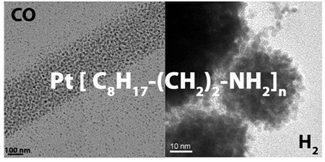Customized platinum nanoparticles

Nanoparticles are as small as a millionth of millimeter. Nevertheless, their applications vary according to the diferent sizes they could have. For their preparation the organometallic approach is well-known and gives rise to well-controlled nanoparticles with tunable size, morphology and surface state. In this article the authors have studied the influence of reaction conditions, most particularly the reactive gas used, on the morphology of platinum nanoparticles obtained by the organometallic approach.
Nanoparticles have a lot of applications in various fields due to their small size and their particular electronic properties. For their preparation the organometallic approach is well-known and gives rise to well-controlled nanoparticles with tunable size, morphology and surface state. The stabilizing agent is also a key parameter and depending of their nature and composition different types of stabilization exist. For catalytic investigations in biphasic media, various heavily fluorinated compounds were tested as protecting agents.
In this work, platinum nanoparticles were prepared through the decomposition at room temperature of the organometallic complex Pt2(dba)3 under dihydrogen or carbon monoxide in the presence of heavily fluorinated ligands. Different morphologies were obtained depending on the reactive gas used.
Under dihydrogen atmosphere, nanoparticulate material was obtained when ligands without functional groups were used as stabilizers. The presence of functional groups on the ligands (this is the case for the fluorinated amines) reinforces their stabilizing effect, giving rise to small and individual nanoparticles. At high ligand concentration the formation of organized particles into spherical superstructures was observed.
Under carbon monoxide atmosphere, carbon monoxide molecules coordinate at the particle surface. This reinforce the nanoparticles stabilization and the role of fluorinated amines as coordinating agents is secondary, acting as a soft organic template and giving rise to nice elongated superstructures.
References
"Self-assembled Platinum Nanoparticles into Heavily Fluorinated Organic Templates: Effect of the Reactive Gas on the Morphology". Mar Tristany, Marcial Moreno-Mañas, Roser Pleixats, Bruno Chaudret, Karine Philippot, Yannick Guari, Victor Matsura, Pierre Lecante. New Journal of Chemistry, 2009, 33, 1529-1534.

